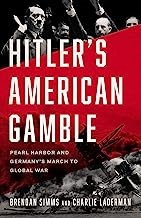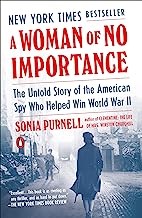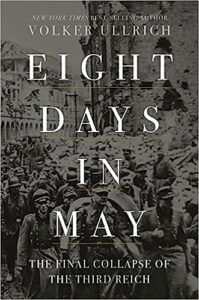AILING HITLER FIRES PERSONAL PHYSICIAN
Wolf’s Lair, Fuehrer HQ, East Prussia • October 10, 1944
Shortly after the July 1944 attempt on Adolf Hitler’s life, an adjutant of the Chief of the General Staff of the Army remarked that the 55-year-old Hitler had the “posture of an old man.” On September 24, 1944, Dr. Theodor Morell, the Fuehrer’s loyal, long-serving physician, noted in his daily calendar that “Patient A” was suffering from heart trouble, stomach aches, and a sore throat. Morell had first met “Patient A” in 1936 at a Munich dinner party thrown by Hitler’s personal photographer, Heinrich Hoffmann. Invited to the Berghof, Hitler’s alpine retreat near Berchtesgaden a few days later, Morell told the German leader, a notorious vegetarian, that he could cure him within a year of some of the intestinal maladies that plagued him. Morell prescribed various commercial preparations, including a combination of vitamins and E. coli bacteria (the probiotic Mutaflor to treat Hitler’s gastrointestinal disorders, primarily flatulence). Hitler seemed to recover and Morell eventually became a member of Hitler’s de facto family circle as well as a member on his team of personal physicians.
On this date, October 10, 1944, Hitler sacked Morell’s rival, Dr. Karl Brandt, Reich Commissar for Health and Sanitation and for a time the leading medical authority in the Nazi regime. Brandt had become convinced that the injections and pills Morell prescribed for the Fuehrer were actually poisoning him. Hitler’s private secretary, Martin Bormann, despaired of the medicinal regimen Morell had created for his addiction-prone, multidrug-using boss, saying the medications needed to be regulated for the sake of the Fuehrer’s increasingly wobbly health. Others in Hitler’s closest entourage—even his mistress, Eva Braun—viewed the plump doctor and his satchel of needles and drugs with suspicion, and Morell became the butt of numerous jokes outside of Hitler’s earshot. Luftwaffe chief and Reich Marshall Hermann Goering, a morphine addict himself, called Morell “Mr. Reich Injection Master” (“Herr Reichspritzenmeister”). Armaments Minister Albert Speer (pronounced “spare”), one of Hitler’s closest associates, called Morell “a bit of a screwball.” (A civilian, Morell took to wearing a military-style uniform, golden rods of Asclepius on his collar, and a cap of his own design.) Hitler, however, chose to view negative comments about Morell as a conspiracy.
Between fall 1941 and 1945 but especially after 1942 when his health was seriously deteriorating partly under the pressures of war, Hitler consumed up to 88 different substances, among them opiates, cocaine, barbiturates (Brom-Nervacit), methamphetamine (Pervitin, touted as an “alertness aid”), “anti-gas” pills that contained strychnine (a poison), laxatives, tonics, the sexual hormone Testoviron, an extract of bulls’ testicles (Orchikrin, supposedly a cure for depression), a substance made from seminal vesicles and prostates of young bulls (Prostakrinum), the painkiller oxycodone (Eukodal, a pharmacological cousin of heroin), glucose, and useless hormones.
By the time of the Normandy invasion in France (Operation Overlord) in June 1944, Hitler’s insomnia and daytime somnolence—common in people with Parkinson’s disease—had noticeably affected his decision-making faculties and allegedly contributed to the slow response of Axis forces in counterattacking Allied beachhead landings. In the month Hitler died, April 1945, Morell recorded treating Hitler with 2 belladonna-based drugs, the treatment of choice at that time for Hitler’s violent hand tremors (Haendezittern) and Parkinson’s (Schuettellaehmung)—2 disorders Morell had tentatively diagnosed in his patient. Interned and interrogated by U.S. military authorities after the war, Morell, unlike Brandt, was never charged with any war crimes. Escaping Brandt’s fate, Morell died from obesity-related health issues in a Bavarian hospital in 1948.
Hitler’s Personal Physicians: Theodor Morell and Karl Brandt, Chief of the Nazi Euthanasia Program (T-4)
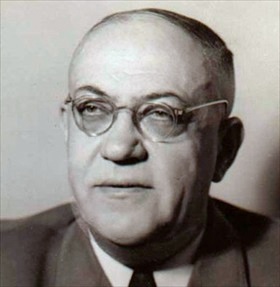 | 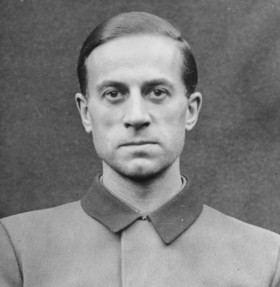 |
Left: Registered as a Nazi Party member in 1933 for the business it brought him, the bespectacled, overweight, balding Theodor Morell (1886–1948) was Hitler’s personal physician until he was fired on April 17, 1945. Morell was well known in Germany for his unconventional treatments. A licensed general practitioner and self-made pharmacist, most people in Hitler’s inner circle regarded him as a quack. Not Hitler, who in 1938 awarded the good doctor an honorary professorship and in February 1944 presented him with the Knight’s Cross of the War Merit Cross. From 1936 onward Morell supplied Hitler with drugs and pills. His medicinal “basic therapy” consisted essentially of a 10- or 20‑percent glucose solution, a vitamin preparation of Morell’s called Vitamultin forte (it also came in a gold-wrapped, semi-tasty bar), the antidiabetic agent Glyconorm, and the metabolic stimulant Tonophosphan. The regimen was intended to cure both physical and mental exhaustion. Between August 1941 and April 1945 Morell treated Hitler essentially 24/7—“at all times of day and night,” he complained. The basic medication or adjuvant medicinal nutrition was administered by intravenous or intramuscular injection. This was perhaps one of the reasons why Goering described Morell as “Reich Minister of Injections” or “Reich Injection Master.” Morell’s notes reveal, however, that “Patient A” appears to have had no objection to these injections (he wanted a quick effect) and regarded them as genuine medication. Over time, though, the veins of the doped-up dictator resembled those of an inveterate junkie—collapsed to the point that injections occasionally had to be cancelled to give his veins time to heal. Hitler’s health deteriorated under the impact of the myriad doping agents Morell prescribed. This was most pronounced after the failed July 1944 attempt on Hitler’s life (Operation Valkyrie). The Fuehrer’s rapid physical decline—pale sunken face, stooped, drooling, and tremorous—coincided with his increasingly rare public appearances and his self-imposed isolation, first in the Wolf’s Lair, his military headquarters buried deep in the East Prussian forests, and then, from February 1945 onward, in the dense claustrophobia of his subterranean Fuehrerbunker in Berlin.
![]()
Right: A member of the Nazi Party’s paramilitary SS (Schutzstaffel) since July 1934, Dr. Karl Brandt (1904–1948), a surgeon, was selected as Hitler’s “escort physician” the next month. Up to October 1944 Brandt was one of two of Hitler’s assistant doctors. Morell, the self-styled “sole personal physician” to Hitler, kept both assistant doctors in the dark over his treatment of the Fuehrer, much to their chagrin and mounting suspicion. From 1939 onwards Brandt headed the Nazi euthanasia program (Action T‑4), in which thousands of people who were medically diagnosed as “incurably sick” (e.g., handicapped, physically disabled, or mentally ill) were granted a mercy death (Gnadentod). Appointed Reich Commissioner for Health and Sanitation in 1942, he became involved in grotesque medical experiments on concentration camp prisoners on a previously unimaginable scale. Brandt was prosecuted in the first round of the Nuremberg Doctors’ Trials. Convicted of war crimes and crimes against humanity, he was hanged on June 2, 1948.
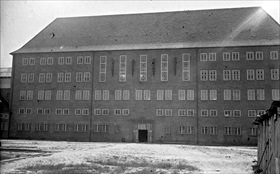 | 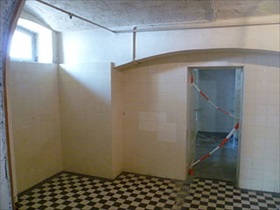 |
Left: A former jail, the Brandenburg Euthanasia Center, officially known as the Brandenburg Welfare Institute, was established in 1939 and acted as a killing center as part of the Nazi euthanasia program. At first patients were killed by lethal injection, but the shortage of doses of increasingly scarce and expensive drugs was soon apparent. Hitler himself recommended to Brandt that carbon monoxide gas be used. At his trial Brandt described this form of systematic murder as a “major advance in medical history.” The first gassings took place at Brandenburg in January 1940 and by the end of the year 9,772 people had been asphyxiated.
![]()
Right: Hadamar in the German state of Hessen housed a psychiatric clinic where 10,072 men, women, and children were asphyxiated with carbon monoxide in a gas chamber designed to look like a shower in the first phase of the T‑4 killing operations there (January to August 1941). Another 4,000 died through starvation and by lethal injection until March 1945. Hadamar’s citizens were aware of what was taking place at the clinic, especially since the cremation process was faulty. This often resulted in a cloud of stinking smoke hanging over the town. Local students would often taunt each other by saying, “You’ll end up in the Hadamar ovens!”
Dr. Theodor Morell: “Patient A” and His Secret Illness
![]()

 World War II was the single most devastating and horrific event in the history of the world, causing the death of some 70 million people, reshaping the political map of the twentieth century and ushering in a new era of world history. Every day The Daily Chronicles brings you a new story from the annals of World War II with a vision to preserve the memory of those who suffered in the greatest military conflict the world has ever seen.
World War II was the single most devastating and horrific event in the history of the world, causing the death of some 70 million people, reshaping the political map of the twentieth century and ushering in a new era of world history. Every day The Daily Chronicles brings you a new story from the annals of World War II with a vision to preserve the memory of those who suffered in the greatest military conflict the world has ever seen. History buffs, there is good news! The Daily Chronicles of World War II is now available as an ebook for $4.99 on Amazon.com. Containing a year’s worth of dated entries from this website, the ebook brings the story of this tumultuous era to life in a compelling, authoritative, and succinct manner. Featuring inventive navigation aids, the ebook enables readers to instantly move forward or backward by month and date to different dated entries. Simple and elegant! Click
History buffs, there is good news! The Daily Chronicles of World War II is now available as an ebook for $4.99 on Amazon.com. Containing a year’s worth of dated entries from this website, the ebook brings the story of this tumultuous era to life in a compelling, authoritative, and succinct manner. Featuring inventive navigation aids, the ebook enables readers to instantly move forward or backward by month and date to different dated entries. Simple and elegant! Click 








